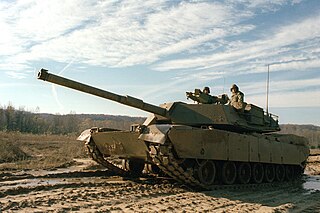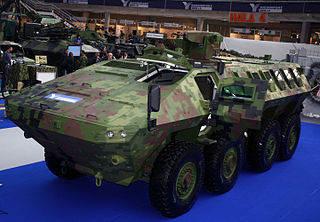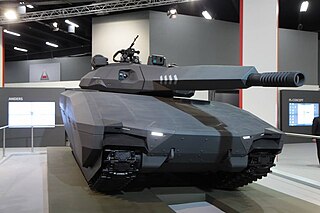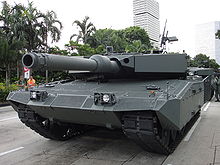
Composite armour is a type of vehicle armour consisting of layers of different materials such as metals, plastics, ceramics or air. Most composite armours are lighter than their all-metal equivalent, but instead occupy a larger volume for the same resistance to penetration. It is possible to design composite armour stronger, lighter and less voluminous than traditional armour, but the cost is often prohibitively high, restricting its use to especially vulnerable parts of a vehicle. Its primary purpose is to help defeat high-explosive anti-tank (HEAT) projectiles.

Chobham armour is the informal name of a composite armour developed in the 1960s at the Military Vehicles and Engineering Establishment, a British tank research centre on Chobham Lane in Chertsey. The name has since become the common generic term for composite ceramic vehicle armour. Other names informally given to Chobham armour include Burlington and Dorchester. Special armour is a broader informal term referring to any armour arrangement comprising sandwich reactive plates, including Chobham armour.

The Leopard 2 is a third generation German main battle tank (MBT). Developed by Krauss-Maffei in the 1970s, the tank entered service in 1979 and replaced the earlier Leopard 1 as the main battle tank of the West German army. Various iterations of the Leopard 2 continue to be operated by the armed forces of Germany, as well as 13 other European countries, and several non-European countries, including Canada, Chile, Indonesia, and Singapore. Some operating countries have licensed the Leopard 2 design for local production and domestic development.

Military vehicles are commonly armoured to withstand the impact of shrapnel, bullets, shells, rockets, and missiles, protecting the personnel inside from enemy fire. Such vehicles include armoured fighting vehicles like tanks, aircraft, and ships.

The LAV III is the third generation of the Light Armoured Vehicle (LAV) family of armored personnel carriers built by General Dynamics Land Systems – Canada (GDLS-C), a London, Ontario, based subsidiary of General Dynamics. It first entered service in 1999, succeeding the LAV II. It is the primary mechanized infantry vehicle of both the Canadian Army and the New Zealand Army. It also forms the basis of the Stryker vehicle used by the U.S. Army and other operators. The Canadian Army is upgrading its LAV IIIs to the LAV 6 standard. Early in its development history it was referred to as the 'Kodiak', but the name was never officially adopted.

The TPz Fuchs from Transportpanzer Fuchs is a German armoured personnel carrier originally developed by Daimler-Benz, and manufactured and further developed by the now Rheinmetall MAN Military Vehicles (RMMV). Fuchs was the second wheeled armoured vehicle to enter service with the Bundeswehr. It can be used for tasks including troop transport, engineer transport, bomb disposal, Nuclear, Biological and Chemical reconnaissance and electronic warfare. RMMV and its predecessors manufactured 1,236 Fuchs 1, mostly for the German Army.

Armour with two or more plates spaced a distance apart falls under the category of spaced armour. Spaced armour can be sloped or unsloped. When sloped, it reduces the penetrating power of bullets and solid shot, as after penetrating each plate projectiles tend to tumble, deflect, deform, or disintegrate; spaced armour that is not sloped is generally designed to provide protection from explosive projectiles, which detonate before reaching the primary armour. Spaced armour is used on military vehicles such as tanks and combat bulldozers. In a less common application, it is used in some spacecraft that use Whipple shields.
Plasan is an Israeli-based company that now specializes in survivability solutions for all domains, the design, development and manufacture of protected vehicles, and most recently maneuvering robotics.
NATO AEP-55 STANAG 4569 is a NATO Standardization Agreement covering the standards for the "Protection Levels for Occupants of Logistic and Light Armored Vehicles".
The ADS, formerly known as AMAP-ADS, is a hard-kill active protection system (APS), developed by the German company ADS Gesellschaft für aktive Schutzsysteme, a subsidiary of Rheinmetall and IBD Deisenroth Engineering, as part of their Advanced Modular Armor Protection concept. The system is also known under the name AAC in Sweden and as Shark in France. Due to its modular design it can be adapted to a broad range of vehicles. In particular, it is capable of protecting light vehicles against large caliber weapons which the vehicles' light armor wouldn't stop.

The Lazar BVT is a Serbian mine resistant ambush protected vehicle (MRAP), manufactured by Yugoimport SDPR and named after Prince Lazar Hrebeljanović. It is not in operational use by the Serbian Army, which uses modified version, Lazar 3.

RG-35, is a South African mine resistant ambush protected vehicle developed by Land Systems OMC, a subsidiary of BAE Systems. The RG-35 was introduced in 2009 as a 6x6 vehicle, and a 4x4 version is also under development with the designers intending to make it a new family of vehicles. Described by BAE Systems as a "new class of vehicle" combining the capabilities of a 4x4 mine protected vehicle and a 8x8 combat vehicle, the RG-35 can be utilized in a variety of roles, including command, ambulance or recovery vehicle.
The Modular Expandable Armor System (MEXAS) is a composite armour system developed by the German company IBD Deisenroth Engineering. MEXAS was introduced in 1994 and has been applied on over 20,000 combat vehicles worldwide. The successor of MEXAS is the Advanced Modular Armor Protection (AMAP).

Composhield A/S is a Danish armor manufacturer and integrator established in 2000. It develops, manufactures and assembles custom-built vehicle armour systems as well as composite add-on armor protection kits for lightweight military tactical trucks and APCs and commercial vehicles.

The LAZAR is a family of multi-role armoured personnel carriers, designed for various applications and missions, designed and developed by Yugoimport-SDPR. There are 3 versions of Lazar family of armoured vehicles: Lazar 1, Lazar 2, and Lazar 3.

The PL-01 was a Polish light tank concept created by OBRUM with support from BAE Systems, based on the Swedish CV90120-T light tank. The concept vehicle was first unveiled at the International Defence Industry Exhibition in Kielce on 2 September 2013, but the project was scrapped in 2015.

Eitan is an armoured fighting vehicle (AFV) developed by the Merkava and Armoured Vehicles Directorate in the IMOD to replace the ageing M113 armoured personnel carrier in use by the Israel Defense Forces. Its APC variant lacks the Iron Fist APS, due to the fact those are not the serial production Eitan vehicles yet. The IFV variant is still not in service.

The BOV M16 Miloš is a Serbian 4x4 multipurpose armoured vehicle (MPAV) used for military and law enforcement applications. It features a V-hull, integrating floating-floor plates, and blast-mitigation seating to protect occupants against land mines and improvised explosive devices (IEDs). The M16 Miloš was first publicly presented at IDEX 2017 exhibition in Abu Dhabi, UAE.
IBD Deisenroth Engineering was a German company specializing in the design of armor for military vehicles. They formed in 1981 to develop applications of a new explosive suitable for use in explosive reactive armor (ERA). Through the 1980s, they developed many individual applications for the Bundeswehr. In 1994, they introduced their MEXAS armor systems using ceramic armor which were very popular as upgrade systems for a wide range of armored vehicles, mostly in NATO. MEXAS was replaced by AMAP in 2006, which includes a wide variety of modular armor, both active and passive.

The Mildef Tarantula HMAV is a Malaysian 4×4 V-hull mine-resistant infantry mobility vehicle that provides high level protection against a variety of battlefield threats such as mines and improvised explosive devices. The vehicle was designed and manufactured by Mildef International Technologies alongside Science Technology Research Institute for Defense (STRIDE) and the Malaysian Armed Forces. It was first launched on 11 February 2021.

















